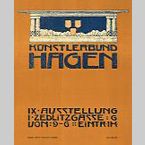Austrian group of artists formed in 1900 in Vienna as "Künstlerbund Hagen", along with the Künstlerhaus and the Secession the third most important Viennese artists´ association, 1938 dissolved by the National Socialists.
Its most prominent members included Heinrich Lefler and Joseph Urban.
The group took its name from Herr Hagen, the landlord of an inn at which artists often met for informal discussion.
Originally called the Hagengesellschaft, most of its members left the Künstlerhaus at the same time as the Secessionists in 1897.
Three years later they left the Secession to form the Hagenbund.
At first the group intended to remain within the Künstlerhaus, and they held their first two exhibitions on its premises.
However, between 1902 and 1912, and again from 1920 until 1930, they exhibited independently in a market-hall (the Zedlitzhalle) converted by Urban.
The group favoured a distinct Art Nouveau style based on folk art and British antecedents, such as the work of Aubrey Beardsley.
Their manner was less extreme than that of the Secessionists, and this contributed to their official success; Lefler and Urban were the major contributors to a pageant held in 1908 in celebration of Francis Joseph?s 60 years on the throne.
The influence of the Hagenbund was felt largely through their illustrations, which were popular with a younger and less upper-class audience than the Secessionists had.
Most notable was the series Gerlachs Jugendbücherei, illustrated with lithographs by Lefler, Urban and Karl Fahringer (1874-1952). Among Austrian artists who participated in Hagenbund exhibitions were Robin Christian Andersen, Anton Hanak, Oskar Laske (1874-1951) and, at times, Oskar Kokoschka and Egon Schiele. Although the group was not dissolved until 1930, its importance had faded by the outbreak of World War I.
Foto: Karolinsky-Archive
